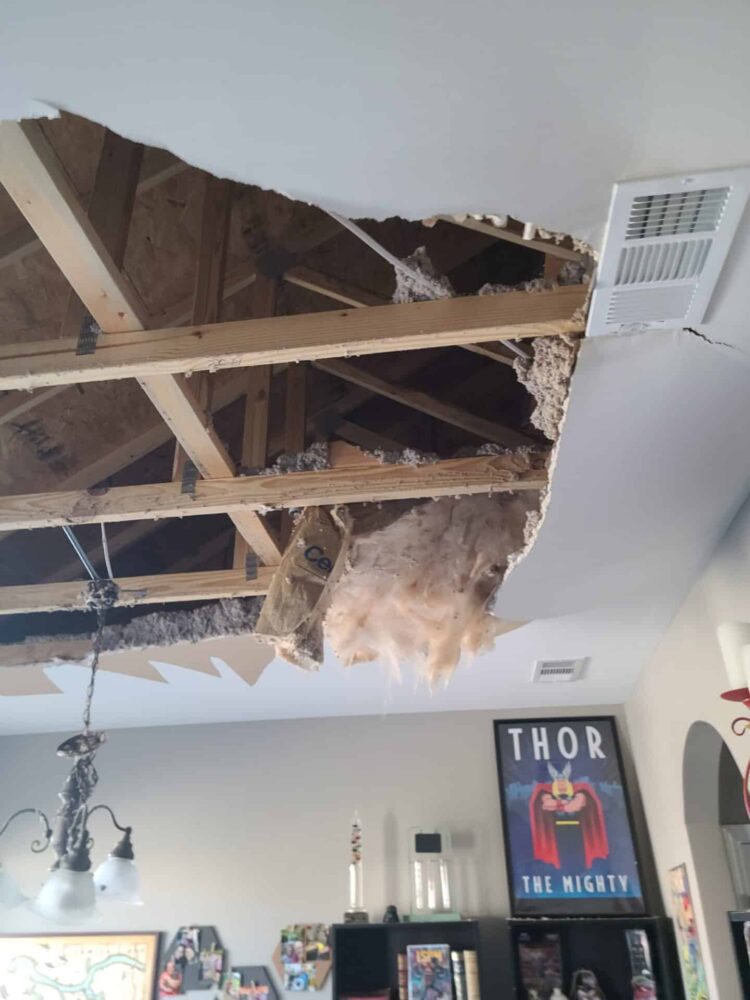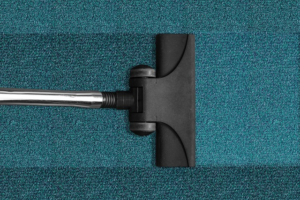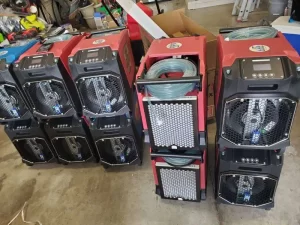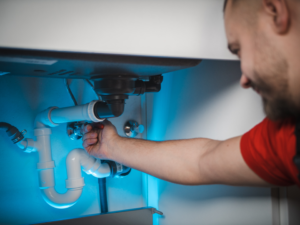How To Find and Deal With Water Leaking From Your Walls
Water damage in walls is a common problem faced by homeowners. It can occur due to various reasons, such as faulty pipes, roof leaks, floods,a water leak and condensation.
If left untreated, water damage can lead to mold growth, damage to the structure, and health issues. Therefore, it is essential to be aware of the signs of water damage in walls and take action promptly. A simple check of the water meter could save you hundreds on repairs.
In this blog post, we will discuss the signs of water damage in walls and how to address them.
Signs of Water Leaks in Walls
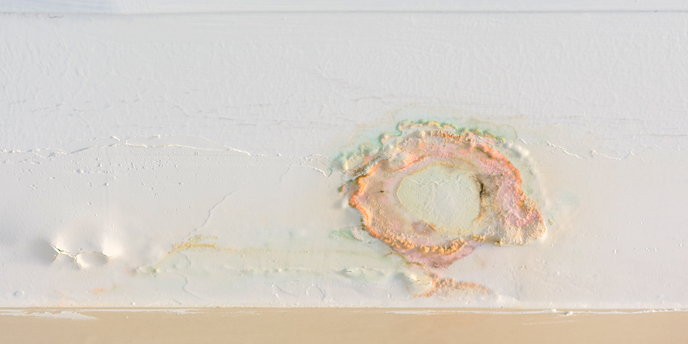
- Discoloration and Stains
One of the most apparent signs of water damage in walls is discoloration or stains. You may notice yellow or brown stains on your walls or ceiling, which are caused by water seeping through the paint or wallpaper. These stains can indicate the presence of water damage, even if there are no visible signs of water.
- Peeling or Cracking Paint
Water damage can cause paint to peel or crack, especially in areas with high humidity or moisture. You may notice bubbling or blistering on the surface of the paint, which can be a sign of water damage. If you see these signs, you should investigate the underlying cause of the problem.
- Warped or Sagging Walls
Water damage can cause walls to warp or sag, which can be a sign of damage. If you notice that your walls are no longer straight or level, you should have them inspected by a professional. They can determine the cause of the problem and recommend the necessary repairs.
- Musty Odor
Mold and mildew thrive in damp environments, and water damage like wall leaks can create the perfect conditions for their growth. If you notice a musty odor in your home, it could be a sign of mold or mildew. These fungi can cause health problems, especially in people with allergies or respiratory issues.
- Cracks in the Walls or Ceiling
Water damage can cause cracks in the walls or ceiling, which can weaken the structure of your home and cause wall leaks. If you notice wet walls or cracks in your walls or ceiling, you should have them inspected by a professional. They can determine the cause of the problem and recommend the necessary repairs.
- Swollen or Soft Drywall
Water damage can cause the drywall to become swollen or soft with bubbling paint, which can be a sign of water damage. If you notice that your drywall feels spongy or soft to the touch, it could be a sign of water damage. You should have it inspected by a professional to determine the extent of the damage and the necessary repairs.
- Water Stains on the Floor
Water damage can cause stains on your floor, which can be a sign of water damage. If you notice stains on your carpet or hardwood floor, it could be a sign of water damage. You should investigate the cause of the problem and address it promptly.
- Dampness or Moisture
Water damage can create a damp or moist environment, which can be a sign of water damage. If you notice dampness or moisture in your home, it could be a sign of water damage. You should investigate the cause of the problem by checking your moisture or water meter and address it promptly.
Common Causes of Water Damage In Walls
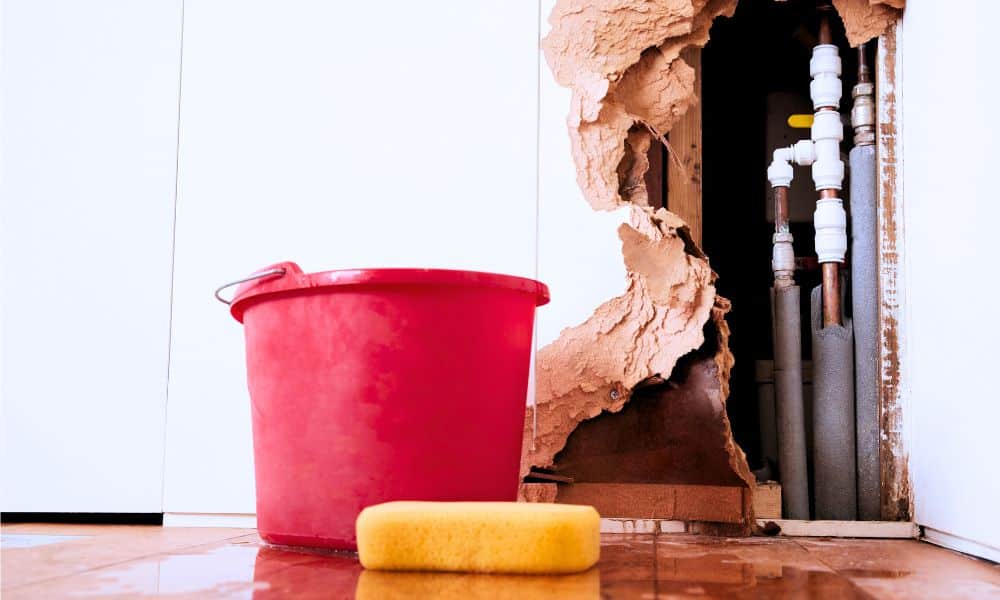
Water damage in walls can be a major problem for homeowners. It can cause structural damage, mold growth, and health issues. Identifying the cause of water damage in walls is essential to address the problem and prevent it from happening again. In this blog post, we will discuss the common causes of water damage in walls.
- Leaking Pipes
Leaky pipes are one of the most common causes of water damage to walls. Pipes can leak due to corrosion, age, or damage from external factors causing low water pressure. Over time, a leaking pipe can cause significant water damage to your walls, floors, and ceilings. You may notice water stains, discoloration, or peeling paint in the affected areas. It’s important to address the leaky pipe promptly to prevent further damage and potential health issues.
- Roof Leaks
Roof leaks can cause water to seep into your walls, which can lead to water damage. If you notice water stains on your ceiling, it could be a sign of a roof leak. Roofs can leak due to age, damage from storms, or improper installation. It’s important to have your roof inspected regularly and address any issues promptly to prevent water damage to your walls and other parts of your home.
- Condensation
Condensation can also cause water damage in walls, especially in areas with high humidity. When warm, moist air comes into contact with a cold surface, it can condense and form droplets of water. Over time, this can lead to mold growth and damage to your walls. You may notice water stains, discoloration, or peeling paint in the affected areas. To prevent condensation, ensure proper ventilation in your home and use dehumidifiers if necessary.
- Floods
Floods can cause significant water damage to your walls and other parts of your home. They can be caused by natural disasters such as hurricanes, heavy rainfall, or overflowing rivers. Flood water can be contaminated and cause health issues if not properly cleaned up. If your home has been affected by a flood, it’s important to address the problem promptly and work with professionals to assess and repair the damage.
- Faulty Appliances
Faulty appliances such as washing machines, dishwashers, and water heaters can also cause water damage in walls. Leaks from these appliances can go unnoticed for a long time and cause significant damage to your walls and floors. It’s important to regularly inspect your appliances and address any leaks promptly to prevent water damage.
- Poorly Sealed Windows and Doors
Poorly sealed windows and doors can also cause water damage in walls. When water seeps through the gaps and cracks around your windows and doors, it can cause damage to your walls and floors. It’s important to ensure that your windows and doors are properly sealed and address any issues promptly to prevent water damage.
In conclusion, identifying the cause of water damage in walls is essential to address the problem and prevent it from happening again.
Leaking pipes, roof leaks, condensation, floods, faulty appliances, and poorly sealed windows and doors are some of the common causes of water damage in walls.
If you notice any signs of water damage in your home, it’s important to address the problem promptly and work with professionals to assess and repair the damage.
The Consequences of an Untreated Leak
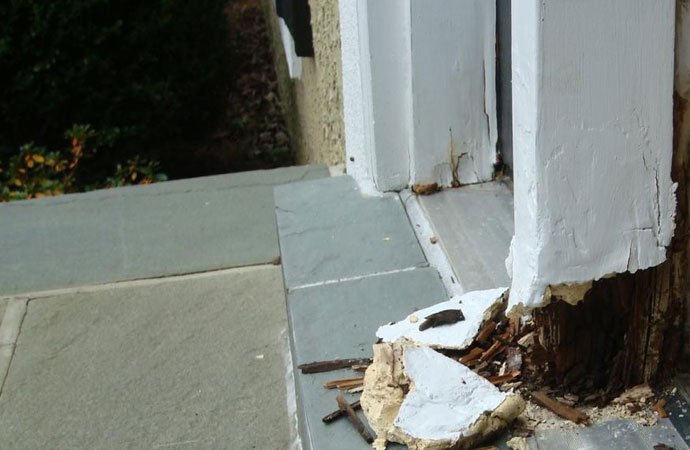
Water damage in general, whether it affects the drywall, floors, ceilings, crawl spaces, or foundation of your home, can have very serious consequences. If the issue does not receive immediate attention, the structural integrity of your home and the condition of your possessions could be at a slight risk.
Water Causes Very Serious Structural Damage
Often, the worst-case scenarios for water leaks or other types of water damage result in structural issues. Materials like wood, concrete, and metal are usually not designed to withstand constant exposure to excess water. When water collects near these materials, it can be absorbed and weaken the structure. Plus, damage can occur to nearby materials and possessions.
Mold Growth
Mold needs a few ingredients to grow, and moisture is one of them. When water damage occurs, it is often followed by mold growth. While visible mold may be easily detected as one of the most straightforward water damage signs, it could also remain hidden, causing musty odors to spread through the home. If you notice musty smells, then start looking for hidden water leaks or faulty appliances. Mold removal may be necessary to get your home back on track.
How to Detect a Water Leak in Your Home?
Water leaks can cause significant damage to your home and lead to unnecessary expenses and a higher monthly water bill. Therefore, it is important to detect water leaks in your home as early as possible. There are several methods that can be used to detect water leakage in your home:
1. Visual Inspection: One of the simplest ways to detect water leaks is through a visual inspection of your home. Look for any signs such as water stains, dampness (wet walls), leak inside a wall, mold on ceilings, or floors.
2. Monitor Moisture Meter: Another effective method is to monitor your moisture meter. Record the reading on your moisture meter and then refrain from using any water in your home for a few hours. After the designated time period, check the moisture meter again.
3. Leak Detection Devices: There are various leak detection devices available on the market that can help detect water leaks in your home like a moisture meter for example. These devices typically work by monitoring the flow of water and alerting you if there is an abnormal increase or decrease in water usage, indicating a potential leak. An infrared camera can also spot leaks. By directing the infrared camera towards the targeted wall surface, any potential leaks will become evident as distinct blue or purple spots.
4. Water Bill Analysis: Pay close attention to your water bills and look for any sudden or unexplainable increases in usage. If you notice a significant increase in your water bill without any corresponding changes in your water usage, it could be an indication of a hidden water leak.
5. Listen for Unusual Sounds: Sometimes, a water leak can be detected by listening for unusual sounds. For example, if you hear the sound of running water when all faucets and appliances are turned off, there could be a hidden leak somewhere in your home.
6. Conduct a Toilet Dye Test: To detect leaks in your toilet, you can perform a simple dye test. Add a few drops of food coloring into the toilet tank and wait for about 15-20 minutes without flushing. Then, check the toilet bowl. If the water in the bowl has changed color, it indicates a water leak in the toilet.
7. Inspect Pipe Connections: Check the connections of your plumbing pipes for any signs of leaks or drips. Inspecting the connections can help identify if there are any visible water leaks in your home.
When To Contact A Professional if There is Water Leaking From Wall
If you have exhausted the aforementioned approaches and are still unable to pinpoint the origin of a water leak in your residence, or if there is an observable leak inside a wall despite your attempts to identify its source, it is advisable to engage the services of a qualified professional.
Seeking assistance from an experienced plumber or proficient water leak detection service becomes imperative when locating the exact cause of a leakage becomes challenging or when visible indications of wall-based water infiltration persist. Numerous sources including studies focused on quantifying water loss and developing advanced methods for detecting leaks corroborate that detecting and localizing instances of pipeline leaks assume paramount importance in safeguarding precious water resources while concurrently minimizing associated expenses.
Contact TN Flood Kings for Water Leakage Assistance
Whether you find a leak inside a wall, a sudden spike in your water bill from high water usage, flaking paint on the living room drywall, or the exterior appears normal but there is a musty smell, calling the professionals at TN FloodKings could save your property, your possessions, and your bank account.
Our water damage restoration company can help minimize collateral damage, find every hidden leak in the home, and initiate a thorough restoration process. We have the tools to save your property, such as a water meter, powerful vacuums, and the right equipment. Contact us the minute disaster strikes. Don’t wait three hours to take action. Watch for the signs of water damage or a leak and address any issues quickly.


